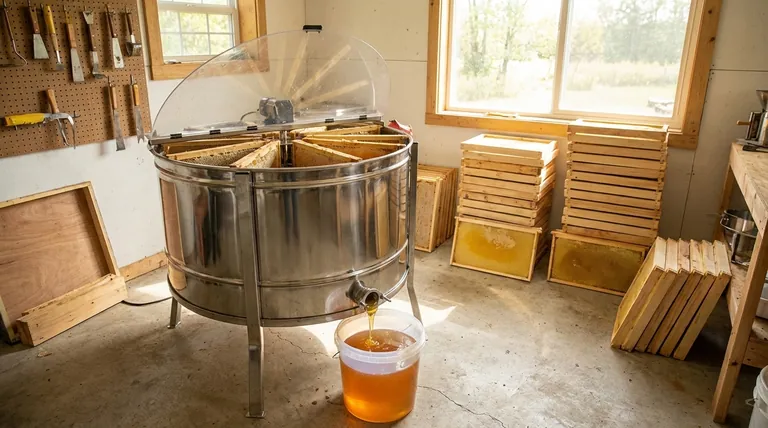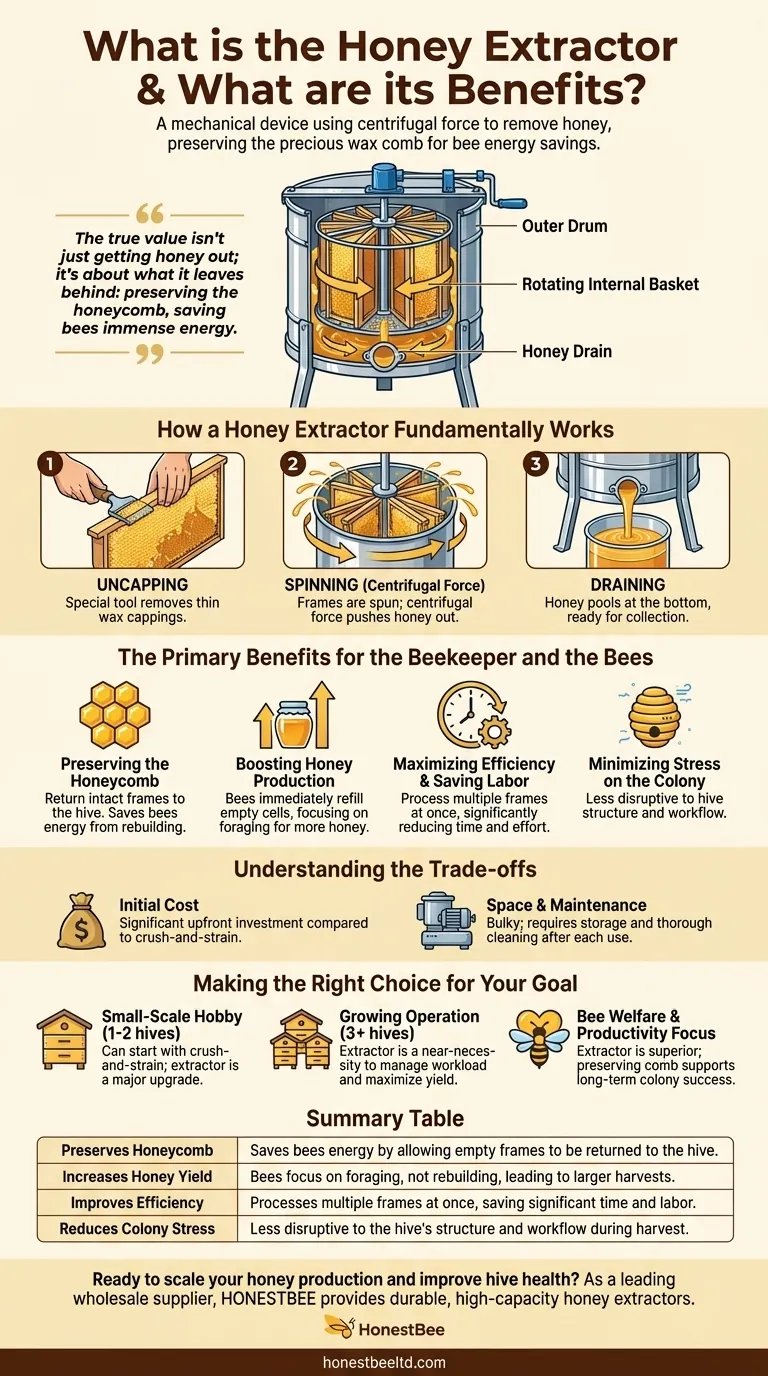At its core, a honey extractor is a mechanical device that uses centrifugal force to remove honey from the comb. It consists of a large drum, typically stainless steel or plastic, with an internal basket that holds the frames of honeycomb. By spinning this basket, the extractor flings the liquid honey out against the walls of the drum, where it drains to the bottom for collection, all without destroying the precious wax comb.
The true value of a honey extractor isn't just about getting honey out; it's about what it leaves behind. By preserving the honeycomb, it saves your bees an immense amount of energy, allowing them to focus on producing more honey instead of rebuilding their home.

How a Honey Extractor Fundamentally Works
A honey extractor is a simple yet brilliant application of physics tailored for beekeeping. Understanding its mechanism reveals why it is so effective.
The Core Principle: Centrifugal Force
The entire operation hinges on centrifugal force. As the frames spin rapidly inside the drum, the force pushes the honey outwards, separating it from the wax cells of the comb.
The Key Components
The device has two main parts: a large outer drum to contain the honey and a rotating internal basket designed to hold several honeycomb frames at once. A spout at the bottom of the drum allows the collected honey to be drained.
The Extraction Process
First, the beekeeper uses a special tool to remove the thin wax cappings that bees place over the filled honey cells. The uncapped frames are then placed in the extractor's basket, which is spun. The honey is flung out and pools at the bottom, ready for filtering and bottling.
The Primary Benefits for the Beekeeper and the Bees
Using an extractor offers significant advantages over older methods like crushing the comb, benefiting both the harvest size and the health of the bee colony.
Preserving the Honeycomb
This is the single most important benefit. Bees expend a tremendous amount of energy and resources to produce wax and construct their comb. By keeping the comb intact, you can return the empty frames directly to the hive.
Boosting Honey Production
Since the bees don't have to rebuild their comb from scratch, they can immediately begin refilling the empty cells. This allows them to dedicate their energy to foraging and producing more honey, leading to a much larger harvest over the season.
Maximizing Efficiency and Saving Labor
An extractor can process multiple frames at once, dramatically reducing the time and physical effort required for harvesting. This makes it an invaluable tool for anyone with more than one or two hives.
Minimizing Stress on the Colony
Returning intact, empty combs is far less disruptive to the colony's structure and workflow. It helps maintain the hive's stability and reduces the overall stress placed on the bees during the honey harvest.
Understanding the Trade-offs
While highly beneficial, a honey extractor is an investment that comes with practical considerations.
Initial Cost
A quality honey extractor represents a significant upfront cost. For a new beekeeper with a single hive, this can be a barrier compared to the simple and inexpensive crush-and-strain method.
Space and Maintenance
These devices are bulky and require adequate storage space. They also must be thoroughly cleaned after each use to prevent contamination and the spread of any potential diseases between hives.
Making the Right Choice for Your Goal
Deciding whether to invest in a honey extractor depends on the scale of your beekeeping and your long-term objectives.
- If your primary focus is a small-scale hobby (1-2 hives): You can start with the crush-and-strain method, but an extractor is a major upgrade for hive health and your own efficiency.
- If your primary focus is growing your operation (3+ hives): An extractor becomes a near-necessity to manage the workload and maximize your potential honey yield.
- If your primary focus is bee welfare and productivity: The extractor is the superior choice because preserving the comb is the single best way to support your colony's long-term success.
Ultimately, choosing a honey extractor is an investment in a more efficient harvest and a healthier, more productive bee colony.
Summary Table:
| Benefit | Description |
|---|---|
| Preserves Honeycomb | Saves bees energy by allowing empty frames to be returned to the hive. |
| Increases Honey Yield | Bees focus on foraging, not rebuilding, leading to larger harvests. |
| Improves Efficiency | Processes multiple frames at once, saving significant time and labor. |
| Reduces Colony Stress | Less disruptive to the hive's structure and workflow during harvest. |
Ready to scale your honey production and improve hive health? As a leading wholesale supplier to commercial apiaries and distributors, HONESTBEE provides the durable, high-capacity honey extractors and equipment you need to operate efficiently and profitably. Contact our team today to discuss your specific needs and discover how our solutions can benefit your operation.
Visual Guide

Related Products
- HONESTBEE 72 Frame Industrial Electric Honey Extractor for Beekeeping
- electric honey extractor honey centrifuge 3 frame honey extractor stainless steel honey frame extractor
- 8-Frame Electric Self-Reversing Honey Extractor Spinner for Commercial Honey Extraction Equipment
- HONESTBEE 3-Frame Manual Acrylic Honey Extractor
- 2 Frame Stainless Steel Manual Honey Spinner Extractor for Beekeeping
People Also Ask
- How is honey harvested from Langstroth hives? A Guide to Efficient, Comb-Preserving Extraction
- What are the two common types of honey extractors? Choose the Right Extractor for Your Apiary
- What are the advantages of automated honey extractors in terms of time efficiency? Boost Your Harvest Speed
- Can a manual extractor be upgraded to an electric one? Save Labor & Boost Efficiency
- How do automatic honey extractors function? Achieve High-Efficiency Honey Harvesting



















